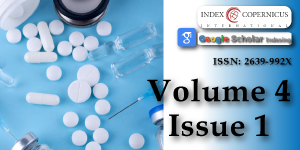Antiuropathogenic and antioxidant activities of Hypoxis hemerocallidea Lam. extracts, and compounds from its taxonomically related species
Main Article Content
Abstract
Hypoxis hemerocallidea Lam is one of the 43 Hypoxis species in South Africa, marketed extensively as over the counter herbal product for the management of several diseases. The plant commercial products link efficacy to hypoxoside 4, its aglycone (rooperol), or β-sitosterol. This study investigated antibacterial and anti-oxidant activities of four other molecules and two extracts from the Hypoxis plant. Visual antioxidant limit of detection and free radical scavenging activities of test samples were determined using 20 mM hydrogen peroxide, 0.4 mM DPPH or ferric reducing antioxidant power assay. Quantitative free radical was determine by spectrophotometric method while antibacterial activity was evaluated using MICs against uropathogens: S. aureus (ATCC25923), S. marcescens (ATCC 14041), P. aeruginosa (ATCC 9721), P. mirabilis (ATCC 33583) and E. coli (ATCC 10536).
Anti-oxidant activities visual limit of detection of 0.06 mg/mL and percentage free radical scavenging activity (IC50 = 0.048 - 0.032 mg/ml) for pure compounds 1 - 4 and (IC50 = 0.037 - 0.039 mg/ml) for extracts were obtained. The reducing power IC50 ranged between 0.15 - 0.23 mg/ml for extracts and 0.11-0.35 mg/ml for standards. Antibacterial potentials show a noteworthy to moderate MIC values of 0.20 - 1.56 mg/ml against S. aureus (ATCC 25923), S. marcescens (ATCC 14041), P. aeruginosa (ATCC 9721), P. mirabilis (ATCC 33583) and E. coli (ATCC 10536). Galpinoside 5, hemerocalloside 3 and curculigoside C 2 are the other active compounds in Hypoxis plant.
Article Details
Copyright (c) 2020 Bassey K, et al.

This work is licensed under a Creative Commons Attribution 4.0 International License.
Mills E, Cooper C, Seely D, Kanfer I. African herbal medicines in the treatment of HIV: Hypoxis and Sutherlandia. An overview of evidence and pharmacology. Nutr J. 2005; 4: 1-6. PubMed: https://www.ncbi.nlm.nih.gov/pubmed/15927053.
Drewes SE, Hall HJ, Learmonth RA, Upfold UJ. Isolation of hypoxoside From Hypoxisrooperi and synthesis of [E]-1,5-bis[3,4-dimethoxyphenyl] pent-4-en-1-yne. Phytochem. 1984; 23: 1313-1316. https://www.sciencedirect.com/science/article/abs/pii/S0031942200804495
Oguntibeju OO, Meyer S, Aboua YG, Goboza M. Hypoxis hemerocallidea Significantly Reduce hyperglycaemia and hyperglycaemic-induced oxidative stress in the liver and kidney tissues Of streptozotocin-induced diabetic male Wistar rats. Evid.-Based Complementary Altern Med. 2016; 2016: 1-10.
Ojewole JAO. Antinociceptive, anti-inflammatory and anti-diabetic properties Of Hypoxis hemerocallidea Fisch., C.A. Mey. (Hypoxidaceae) corm [African potato] Aqueous extract in mice and rats. J Ethnopharmacol. 2006; 103: 126-134. PubMed: https://www.ncbi.nlm.nih.gov/pubmed/16191469
Laporta O, Perez-Fons L, Mallavia R, Caturla N. Isolation, characterization and antioxidant capacity assessment of the bioactive compounds derived from Hypoxis rooperi corm extract (African potato). Food Chem. 2007; 101: 1425-1437. https://www.sciencedirect.com/science/article/pii/S0308814606002925
Marini-Bettolo GB, Nicoletti PM, Galeffi C. Research on African medicinal plants-II: Hypoxoside a new glycoside with uncommon structure from Hypoxis obtusa busch. Tetrahedron. 1982; 38: 1683-1687. https://www.sciencedirect.com/science/article/abs/pii/0040402082801476
Galeffi C, Multari G, De Vicente Y, Messan I, Nicolleti M, Marini-Bettolo GM. Two New Glucosides from Hypoxis obtusa: Obtuside A and Obtuside B. Planta medica. 1989; 55: 318-320. https://www.thieme-connect.com/products/ejournals/abstract/10.1055/s-2006-962019?device=mobile
Van Staden J. Constituents of Hypoxis rooperi, a valuable medicinal plant in South Africa. Deutsche Apotheke Zeitung. 1989; 33: 460-464.
Bassey K, Viljoen A, Combrinck S, Choi YH. New phytochemicals From the corms of medicinally important South African Hypoxis species. Phytochem Lett. 2014; 10: lxix–lxxv. https://www.sciencedirect.com/science/article/abs/pii/S1874390014001748
Bitew A, Molalign T, Chanie M. Species distribution and antibiotic susceptibility profile of bacterial uropathogens among patients complaining urinary tract infections. BMC InfectDis. 2017; 17: 1-8. PubMed: https://www.ncbi.nlm.nih.gov/pubmed/28962545
Tabibian JH1, Gornbein J, Heidari A, Dien SL, Lau VH. et al. Uropathogens and host characteristics. J Clin Microbiol. 2008; 46: 3980-3986. PubMed: https://www.ncbi.nlm.nih.gov/pubmed/18842936
Foxman B, Barlow R, D'Arcy H, Gillespie B, Sobel JD. Urinary tract infection: self-reported incidence and associated costs. Ann Epidemiol. 2000; 10: 509-15. PubMed: https://www.ncbi.nlm.nih.gov/pubmed/11118930
Foxman B. Epidemiology of urinary tract infections: incidence, morbidity, and Economic costs. Am J Med. 2002; 113: 5-13. PubMed: https://www.ncbi.nlm.nih.gov/pubmed/12113866
Mon MM, Maw SS, Oo ZK. Quantitative determination of free radical scavenging activity and antitumor activity of some Myanmar herbal plants. Int Sch Sci Res Inn. 2011; 5: 92-98. http://www.ipcbee.com/vol11/22-T046.pdf
Pauw E, Eloff JN. Which tree orders in southern Africa have the highest antimicrobial activity and selectivity against bacterial and fungal pathogens of animals? BMC Complement Altern Med. 2014;14: 1-12. PubMed: https://www.ncbi.nlm.nih.gov/pubmed/25164197
Bredenkamp MW, Drewes SE, Wentler GL. A geraniol glycoside from Hypoxisacuminata. Phytochem. 1989; 28: 263-265. https://www.sciencedirect.com/science/article/abs/pii/0031942289850538
Van Vuuren S. Antimicrobial activity of South African medicinal plants. J Ethnopharmacol. 2008; 119: 462-472. PubMed: https://www.ncbi.nlm.nih.gov/pubmed/18582553
Nsibande BE, Gustavsson K, Zhu L. Analysis of health-associated Phytochemical compounds in seven Hypoxis species. AJPS. 2018; 9: 571-583. https://pdfs.semanticscholar.org/949d/3e30c54269cc6579ae3cfcb7e8c271b9ddef.pdf
Mannathoko N, George S, Souda S, Chabaesele K, Goercke I. An in vitro Analysis of the antioxidant and antimicrobial properties of the methanol extract of Hypoxis hemerocallideacorm (MEHHC) from Botswana. MRJI. 2017; 19: 1-12. https://scite.ai/reports/an-in-vitro-analysis-of-the-N593dw
Lundberg WO, Halvorson HO, Burr GO. The antioxidant properties of nordihydroguaiaretic acid. Oil & Soap. 1994; 21: 33-35. https://link.springer.com/article/10.1007/BF02593156
Nair VDP, Dairam A, Agbonon JT, Arnason BCF, Kanfer I. Investigation of the antioxidant activity of African potato (Hypoxis hemerocallidea). J Agric Food Chem. 2007; 55: 1707-1711. https://pubs.acs.org/doi/abs/10.1021/jf0619838
Katerere DR, Eloff JN. Anti-bacterial and anti-oxidant activity of Hypoxis hemerocallidea (Hypoxidaceae): Can leaves be substituted for corms as a Conservation strategy? SAJB. 2008; 74: 613-616. https://www.sciencedirect.com/science/article/pii/S025462990800197X
Matotoka MM, Masoko P. Evaluation of herbal concoctions sold at Gamaja (Limpopo Province) in South Africa and in vitro pharmacological evaluation of plants used to manufacture the concoctions. J Evid Based Complem Altern Med. 2017; 22: 805-815. https://www.ncbi.nlm.nih.gov/pmc/articles/PMC5871308/
Wu D, Wang H, Tan J, Wang C, Lin H, et al. Pharmacokinetic and metabolism studies of curculigoside C by UPLC-MS/MS and UPLC-QTOF-MS. Molecules. 2019; 24: 21. PubMed: https://www.ncbi.nlm.nih.gov/pmc/articles/PMC6337338/





